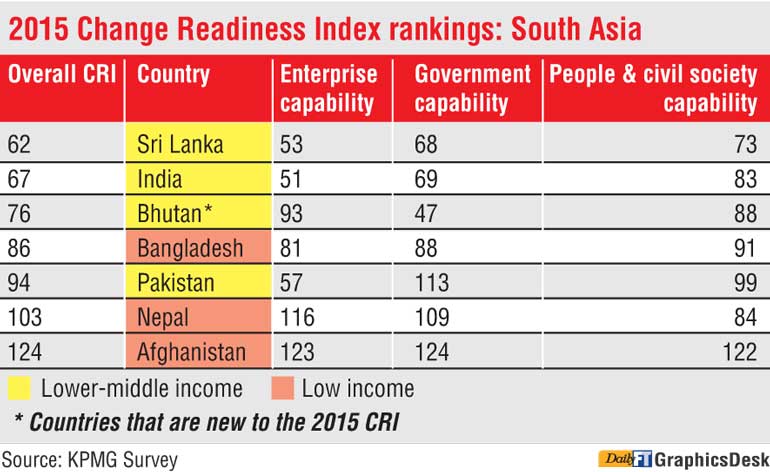Saturday Jan 11, 2025
Saturday Jan 11, 2025
Thursday, 9 July 2015 00:15 - - {{hitsCtrl.values.hits}}
responding to change

Sri Lanka has emerged as the country best equipped to respond to growing political, economic and social changes in the South Asian region, according to KPMG’s latest Global Change Readiness Index (CRI).
The CRI is the only global study of its kind, ranking 127 countries for their capacity to prepare for and respond to accelerating change brought about by everything from natural disasters and economic and political shocks to long-term trends such as demographics and new technologies.
Sri Lanka, which is in a year of political transition, was ranked 62nd among 127 countries globally and five places above neighboring India, topping the countries from South Asia. Sri Lanka has shown immense growth in terms of change and has surpassed most of the Millennium Development Goal (MDG) targets set for 2015, outperforming nearby country comparators on most MDGs.
With a new president arriving in office in January on a mandate of political and economic change, Sri Lanka has emerged as a high growth market with a marked fall in inflation and a narrowed down current account deficit. Since the civil war ended, growth during the past five years has been in the form of a peace dividend resulting from reconstruction efforts and increased consumption.
KPMG in Sri Lanka Managing Partner Reyaz Mihular stated: “The CRI is an important contribution to the development debate, reflecting KPMG’s commitment to new approaches and insights. It informs efforts to build greater change readiness and seize new opportunities that benefit society. As a 118-year-old firm, we strongly believe that change is inevitable and of the utmost importance in order for us to be successful.”
The 2015 CRI provides unique and, in some cases, unexpected insights with smaller, less wealthy and resource-endowed countries often outperforming larger economies on key measures of change readiness.
A number of lower income countries perform well in the CRI, demonstrating the benefits of effective policy and investment in compensating for lower levels of wealth. The Philippines, Indonesia and Cambodia are lower-income countries that all ranked within the top 50 of the index.
“A revealing trend from this year’s CRI, isthe presence in the top 50 of a number of upper-middle and lower-middle income countries, as well as Cambodia, demonstrates that income alone will not make a country ready for change.” noted Reyaz.
Produced in partnership with Oxford Economics, the CRI is designed for use by both the public and private sectors to better inform decisions on policy making and investments. The release of the CRI comes as United Nations member states prepare to adopt Sustainable Development Goals in September that will help guide policies for the next 15 years.
Determining a Country’s Change Readiness
In assessing capability for change readiness, the CRI measures a country’s capacity in three areas:
Enterprise capability – a country’s business environment
Government capability – including fiscal, regulatory and security aspects
People and civil society capability – civil society institutions, inclusiveness of growth, education, health and technology access
As governments and businesses compete for investment and resources on a global stage, and cope with population growth, climate change, urbanization and resource scarcity, such detailed understanding could help break down barriers to growth and development and ensure better preparedness for change.